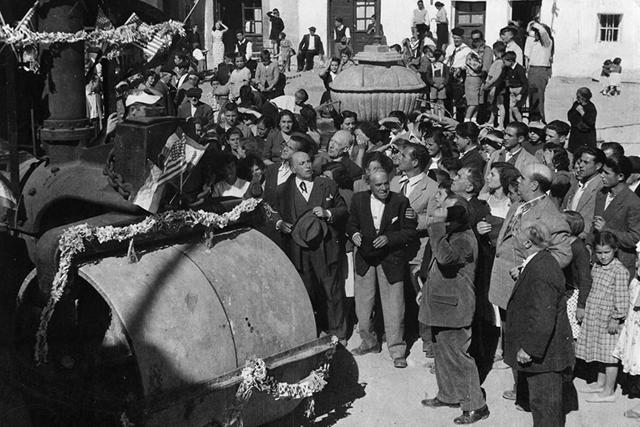Welcome, Mister Marshall

Don Pablo, the mayor of a Castilian village called Villar del Río, is visited by the General Delegate, who tells him of the immediate arrival of a delegation from the government of the United States as part of the European Economic Recovery Plan. Both the local powers that be and the town’s most humble inhabitants receive the news as a great event which will cover their most urgent needs and fulfil their most coveted dreams. Despite some people’s reticence and distrust, the authorities decide to organize a warm welcome for the Americans with the help of Manolo, the agent of a folkloric singer, Carmen Vargas, who is touring their town. The plan consists of changing the features of this austere Castilian village and turning it into a typical Andalusian village, full of colour and happiness.
The population of Villar del Río re-enact their fears and wishes with the imminent arrival of the Americans in their sleep. They even draw up a list of petitions where each one of them asks for what they need most or they wish to have. All this results in the most varied petitions, from a cow to a sewing machine, all the way up to binoculars. When the day comes and everything is ready to welcome the Americans, the delegation passes through the village without stopping at all. Disappointed, the inhabitants of Villar del Río take off their fake costumes and go back to their daily routine. They all contribute with their valuables to pay for the expenses of the Andalusian charade in an act of solidarity.
Production: Uninci (Madrid).
Director: Luis García Berlanga.
Story: Juan Antonio Bardem and Luis García Berlanga.
Screenplay: Juan Antonio Bardem, Luis García Berlanga and Miguel Mihura.
Director of Photography: Manuel Berenguer (B/W).
Music: Jesús García Leoz.
Songs: José Antonio Ochaita, Antonio Valerio and Juan Solano.
Editor: Pepita Orduña.
Set Decorator: Francisco Canet.
Costume Design: Eduardo de la Torre.
Production Manager: Vicente Sempere.
Assistant Director: Ricardo Muñoz Suay. Continuity: Francisco Yllera. Second Cameraman: Eloy Mella. Assistant Camera: Jesús Rosellón. Still photographer: Miguel Guzmán. Production Assistant: J.C. Valencia. Unit Production Manager: Federico del Toro. Make-up Artist: Antonio Florido. Hair Stylist: Charito Vaquera. Sound Engineer: Antonio Alonso. Production Secretary: Pablo Tallaví. Assistant Editor: Alicia Castillo. Assistant Decorator: Enrique Vidal. Assistant Sound Engineer: Lorenzo Lainez. Supervisor: Sirio Rosado. Carpenter and Props: Mateo and Luna. Costume Design: Peris Hermanos. Set Constructor: Francisco R. Asensio. Film Studios: C. Lineal (Madrid). Laboratory: Ballesteros and Arroyo (Madrid).
Cast
Lolita Sevilla (Carmen Vargas), Manolo Morán (Manolo), José Isbert (don Pablo, the mayor), Alberto Romea (don Luis, the gentleman), Elvira Quintillá (Miss Eloísa, the teacher), Luis Pérez de León (don Cosme, the priest), Félix Fernández (don Emiliano, the doctor), Fernando Aguirre (Gerónimo, the secretary), Joaquín Roa (Julián, the town crier), Nicolás Perchicot (chemist), José Franco (national delegate), Rafael Alonso (delegate), José María Rodríguez (José), Elisa Méndez (doña Raquel), Matilde López Roldán (doña Matilde), José Alburquerque (Florentino), Ángel Álvarez (Pedro), Manuel Rosellón (Wise Man), Pepito Vidal (Pepito), José Vivó (Secretary #1), Manuel Alexandre (Secretary #2), José Castillo (Secretary #3), Joaquín Bergia (Cowboy #1), Rafael Cortés (Cowboy #2), José Riesgo (Cowboy #3), Pablo Tallaví (inquisitor) and Fernando Rey’s voice (narrator).
Awards
Award for best comedy film and Special Mention for the screenplay at the Cannes Film Festival.
Award for best film from the Showbusiness National Union, Spain.
Award for best national film from the Triunfo magazine.
Award for best story and best music from the Cinematographic Writers Guild, Spain.
Filming Location
Guadalix de la Sierra (Madrid).
More information
Release Date: 4 April 1953.
Official Film Rating: Interés Nacional (National Interest).



















